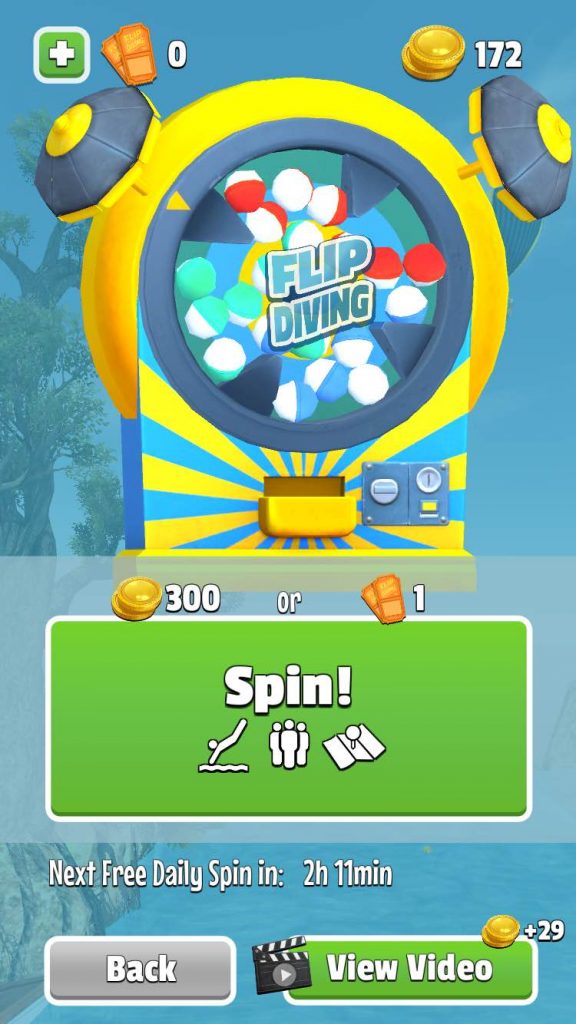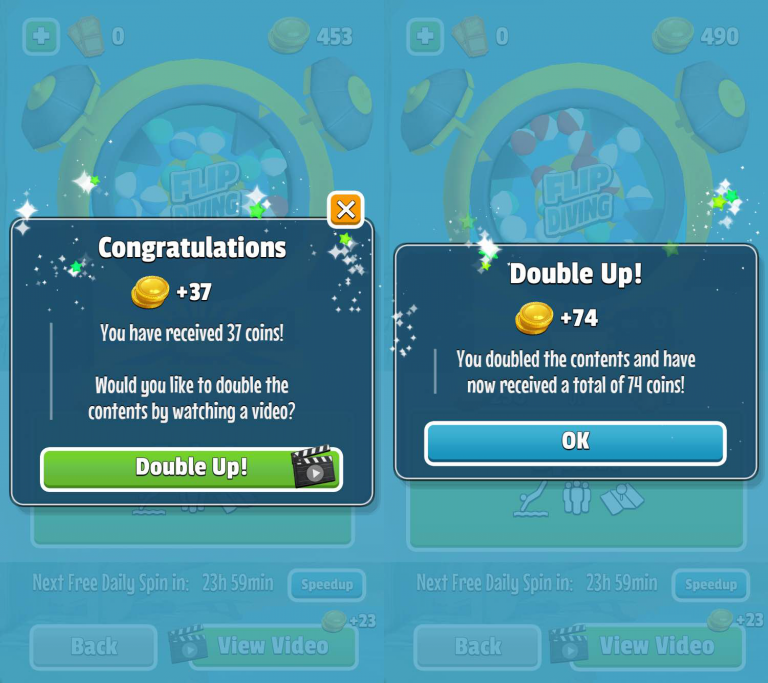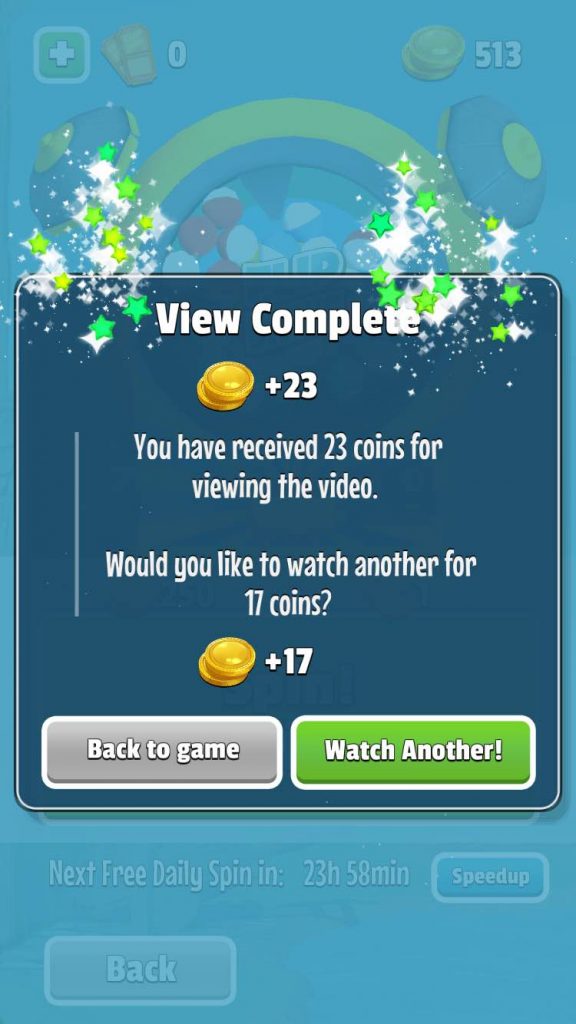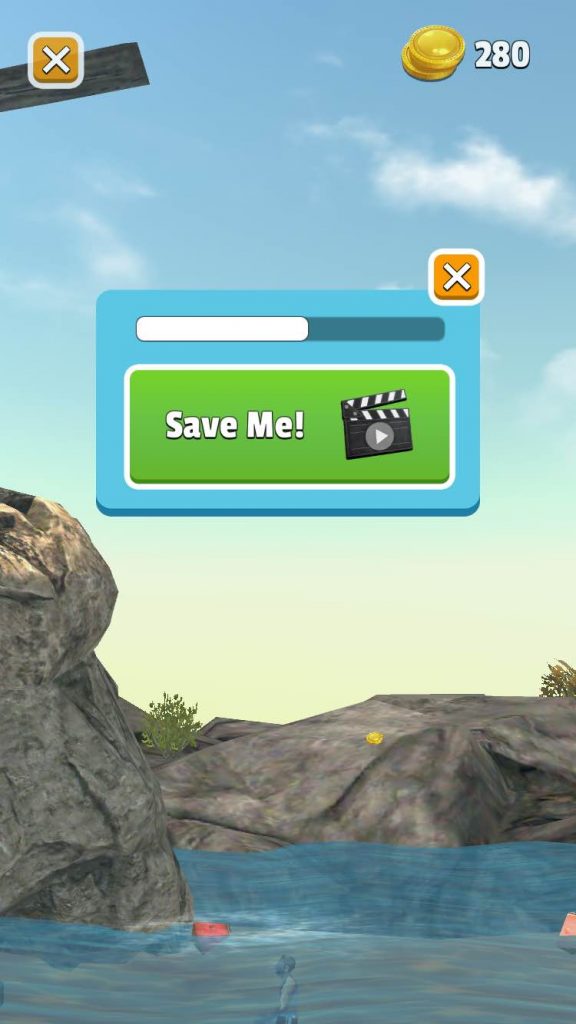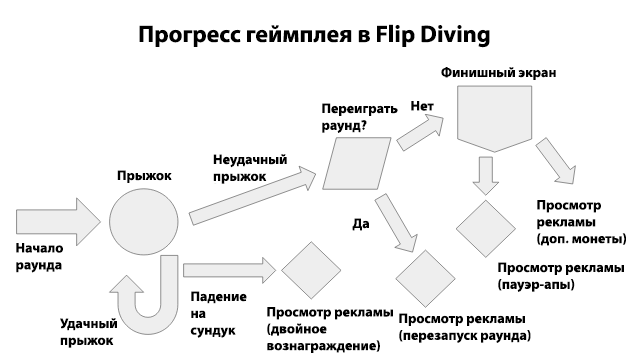Eric Seufert, former vice president of acquisition and user engagement at Rovio and a partner at the consulting agency Heracles Media, spoke about how the game was monetized through advertising Flip Diving.
The original version of the material can be found on Mobile Dev Memo, a website dedicated to the mobile industry, run by Eric Seferth himself, author of the book Freemium Economics.
Flip Diving is a physics-based diving simulator. The game was developed by the Finnish company MobileVolt Games and published by the publisher Miniclip. The title was released on iOS and Android on August 17. Both platforms actively promoted the project. As a result, the game got to the 1st place in the American top for iOS downloads on August 23 and lasted there until August 30.
The gameplay of Flip Diving is extremely uncomplicated: the player forces the character to dive from various high objects, while controlling the angle of the jump and the direction of the fall. The game has a map with many locations. You can dive from a variety of points: from cliffs, from a balloon basket, from a tower in a millionaire’s pool, from a tall tree, and so on.
At each location, the player is first located very close to the water surface. After each successful jump, the character rises to an ever higher springboard. After four jumps (from an ever-increasing height), the player is again placed at the lowest level, but now he has to dive into a much smaller area of water. The round continues until the player makes a mistake and the character falls on his back or stomach. As soon as this happens, the round ends. At the end of each round, the user is awarded several coins, the number of which depends on both the number of jumps and their quality (that is, on the angle at which the character entered the water).
Locations are opened, including for money, but the rest of the content will only win in a kind of “lotto”. This is a spin machine that works on the gacha principle – to get a random ball with game content or coins, the player needs to “spin” the barrel.
There are three types of game content in Flip Diving: these are new characters, new locations and new tricks (for example, backflip, forward flip, “bomb”). That is, “lotto” is the basis of the gaming economy. Players get one free spin every day.
There are two types of soft currency in Flip Diving: coins that the player receives after a series of jumps, and tickets that can be bought in packs for real money. You can pay for the spin machine rotation either with tickets or coins.
The “lotto” icon is visible almost constantly, except for those moments when the character dives. This is because the player’s progress depends on the spin machine: without it, it will not be possible to open new content (except for locations, which, again, can be bought directly).
So the progress cycle looks like this:

Moreover, for the first time, the player has to use a free spin immediately after downloading the application.
At first glance, the progress cycle is quite simple. But behind this apparent simplicity lies a complex monetization cycle. It increases the amount of in-game currency that a player receives from watching video ads in one session.
Firstly, when a player launches a spin machine and receives coins rather than content (which is most likely), he can double the amount of currency by watching videos.
But even before (or after) after the player has used up the free spin, he can watch the video and get coins. And just like in the previous case, immediately after viewing one ad, he is offered to view another one and receive an additional reward.
The player cannot always view video ads from the spin machine screen: the frequency of such views is regulated by a timer. But as soon as the user purchases another spin for coins or tickets, this option becomes available again.
Plus, the player can reduce the gap between getting a free spin by 7 hours by watching a video. This interval can be shortened several times (by several views of the ad). So the spin machine cycle is quite complicated and looks something like this, and every time a player spends coins or tickets, he gets another spin.
Similarly, the ostentatious simplicity of the gameplay in Flip Diving hides a complex monetization system based on the jumping game mechanics described at the beginning of the article. The player’s goal is to make as many successful jumps as possible in each round, and the better the better. During the fall, the player collects coins, and then is rewarded with them, depending on how many times he jumped and how many points he earned for each jump.
After each jump on the end of the round screen, the player is given the opportunity (not always) to view ads for two reward options:
- activate (starting from the next round) a power-up for five minutes, which will simplify either collecting coins or jumping (the second power-up allows you to control the character’s fall in slow motion);
- watch the video and get extra coins.
If the jump was unsuccessful, then even before the finish screen appears, the player is offered to watch a video to restart the round with the last successful attempt.
In addition, every hour a player can land on a chest. This is another separate gacha mechanic: a randomly selected reward is contained inside. As in the case of the spin machine, if there are coins in the chest, the player will be offered to double their number by watching the video.
In fact, throughout the entire game cycle, you can watch a video at any time, either to continue playing or to increase the reward. It looks something like this:
If the cycle seems overloaded, it’s because Flip Diving, apparently, is sharpened for very numerous and short daily gaming sessions. Given that the rewarded videos last for 30 seconds, in order to gain 1-2 views per session, the player needs to be constantly given the opportunity to view ads.
In the case of casual games, it all comes down to the design of the sessions. The fact is that the first ad impression brings the publisher more money than several consecutive impressions. And this means that with the same number of impressions, the publisher will earn more from many short sessions than from several long ones. That is, casual games, which are monetized mainly through video advertising, are best suited with numerous short sessions.
But in order to cram impressions into short gaming sessions, you need to demonstrate the wonders of UI design: the smartphone screen imposes a certain limit on how many views at a time you can offer the player. Flip Diving has found a way to circumvent the restrictions. The player is not shown multiple advertising options on the same screen. Instead, the impressions are tied to each other so that they follow one after the other (which increases the reward in the spin machine).
The design problem in Flip Diving was solved non-intrusively and quite delicately: despite the fact that each session accommodates an impressive number of potential impressions, the player does not feel that he is being stuffed with advertising.
A source: Mobile Dev Memo
Translated by Irina Smirnova






